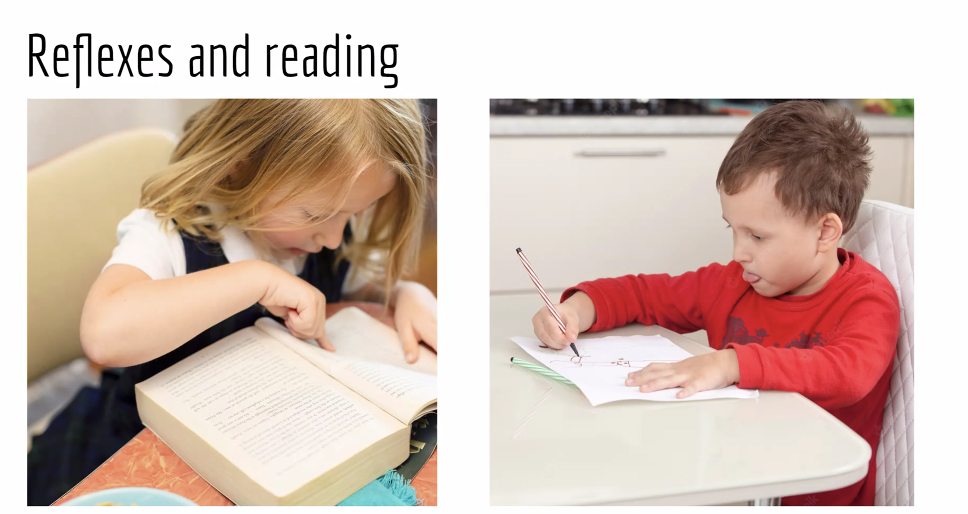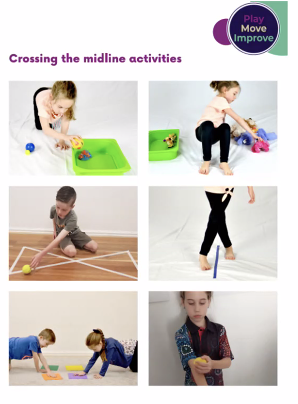Robyn Papworth - how to support children who are finding reading stressful
Notes from webinar:
Before learning to read we need to build the foundation for reading.
Saccades - jumping eyes from point to point.
Persuit - smooth from start to finish egwatching car move across infront of us
Fixation - eg stop a numberplate of car, ball - stick things on ball - watch ball then watch stop and fix on stop point.
Classroom entry video available - 5 movements on video that can run children through after break.
Nurses torch, some interesting point to focus on. Look left, look right, look up, look down. chin should be still. Lately Robyn has seen much whole head movement and increase of number of children finding this difficult. Should be smooth eye movement. Track and fix to object on wall - this is disorientating for some children. Eye fatigue and frustration.
Reading involves eyes chunking code using saccades, persuit and fixation. Encourage movement breaks to include visual tracking practise.
Children can't focus on the page if we haven't developed visual tracking skills. Covid has impacted this also. Working on windows can be awesome part of activities/intervention - includes reflection, light, shadow, heads up/moving - eg finding words on windows to circle. Building foundation children need not just what word looks like. Make it playful - books/reading/writing can be an anxiety trigger for some children. Clear rules around using resources e.g. magnifying glass/torch goes in tub if not used properly.
DIY pinwheel - look on Pinterest. Write words on pinwheel - spin, watch words then fixate on one word/letter on wheel.
Vestibular system - in our lower ear. tells our core to turn on. importance for balance. To coordinate our eyes we need to coordinate our head movement. VOR - vestibular ocular reflex. Challenge for teachers is that children's heads staying more still when on screens. Important to find balance - ie screen time then basketball, Twister, dance - head movement. Some children will avoid this - can get dizzy, disorientated if not practised often - so small increments to start for some. Frog leaps are good. Vestibular system learns quickly. Can improve in 1-2 weeks with planned, regular vestibular activities. ie pencil cases kept on floor means kids have to look down and move head to get it. Position children who need more vestibular practise tote trays further to bottom. Activities more on the ground if possible. Bear walking. When we are reading we need eyes and vestibular.
Track more when in landscape rather than portrait.
Movement to support reflexes important -
e.g. When turn head, shoulder corkscrews (from baby coming out birth canal). Helps us roll over. Not good for reading - elbow follows movement of head. Scan across page and arm wants to move. Movements shared that can be part of routine to get head moving differently from shoulder. Symmetrical neck reflex makes it hard not to move arms and legs together.
- this generation of children not as active. Floppy core. Small group tummy time is good. Encourage core strength activities. These are available on her website and Facebook page.
5 ways educators can improve children's motor skills- this generation of children not as active. Floppy core. Small group tummy time is good. Encourage core strength activities. These are available on her website and Facebook page.
Crossing the midline - using both sides of brain at same time. Babies don't have this skill. By about 4y brain is developing and working as a team. Robyn gets children to draw rainbow on landscape large paper. Child in middle and draws rainbow from one side to another. Often children will swap hands or lots of upper body movement. This can show crossing the midline challenge. Tapping opposite hands to knees can be a challenge for some children too - requires use of both sides of brain.
Why do we need it - to read across page/white board. If we can cross midline can see words across page. If my body can't cross midline, eye can't. Might write small and in middle of page, or on one side of page depending if left or right handed. Tapping opposite hands to knees and arm robots are good exercises.
Spatial awareness - concept of space - where am I in space? easy test - children line up, ask them to tap their nose then tap your finger. Looking for body awareness (tapping nose) and spatial awareness (tapping teacher's finger). Playground breaks - with purpose and set routine ie spin, monkey bars and slide (some children would avoid the things they need to practise if free play) - build vestibular system (this gives us info about space), eg sliding (feeling speed - builds spatial awareness). Building shapes and numbers etc in multi-sensory way is good. Need spatial awareness to be able to see there are short and tall letters. Puzzles (some better than others) important. Stacking.
Learning starts with sounds - brain is designed for sound/language but needs to be taught to read (not natural). When playing with children eg "we're playing with blocks" - clearly pronounce, provide children with the sounds. Getting children to pay attention to what sound they can hear - ie car going past etc.
Play schemas - collecting and connecting. Some children may not have had these experiences and seems to be a gap for many students. Reading is a code that often has groups and categories.
This was a really informative and practical session - recommend. The ideas shared seem really easy to implement with few resources required. It will be good to share with teachers and learning assistants and make sure we are aware of the importance of these skills and incorporating and incorporating supporting activities into our programmes and interventions.





Thanks for sharing. I hadn't considered visual tracking being a barrier to kids learning to read but this really makes sense. Great to see there are lots of playful ways for teachers to help kids with this skill.
ReplyDelete